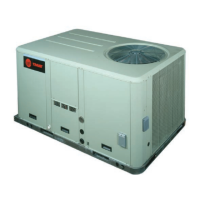Sequence of Operation
68 RT-SVX21AC-EN
Momentarily jump across the Test 1 and Test 2 terminals
of the LTB1 until the unit enters test mode 7 (See Table 16,
p. 51). Once the unit is in the reheat test mode, verify that
the 3 way valve ha
s shifted to the reheat position and that
the supply temperature rises 10°F more than when in
cooling mode stage 2.
Monitor the suction pressure for 15 minut
es. The suction
pr
essure should remain within 5 psi of normal cooling
operation.
Gas Heat Units
Open the main disconnect switch to shut the unit off and
to reset the RTRM.
ReliaTel™ Control: Follow the Test Guide in Table 16,
p. 51 to start the unit in the heating mode. Momentarily
jump across the
Test 1 and Test 2 terminals on LTB1 one
additional time if continuing from previous component
start-up or until the desired start-up component Test is
started.
Electromechanical Control. Using the Service Test
Guide perform the proper test mode connections.
When starting the unit for the
first time
or servicing the
heaters, it is a good practice to start the heater with the
main gas supply turned “Off”.
Once the ignition system and components have been
checked, open t
he main power disc
onnect switch to reset
the unit.
Final System Setup
After completing all of the pre-start and start-up
procedures outlined in the previous sections (i.e.,
operating the unit in each of its Modes through all
available stages of cooling and heating), perform these
final checks before leaving the unit:
• Program the Night Setback (NSB) panel (if applicable)
for proper unoccupied operation. Refer to the
programming instructions for the specific panel.
• Verify that the Remote panel “System” selection
switch, “Fan
” selection switch, and “Zone
Temperature” settings for automatic operation are
correct.
• Inspect the unit for misplaced tools, hardware, and
de
bris.
• V
erify that all exterior panels including the control
pa
nel do
ors and condenser grilles are secured in place.
• Close the main disconnect switch or circuit protector
switch th
at provides the supply power to the unit’s
terminal block or the unit mounted disconnect switch.

